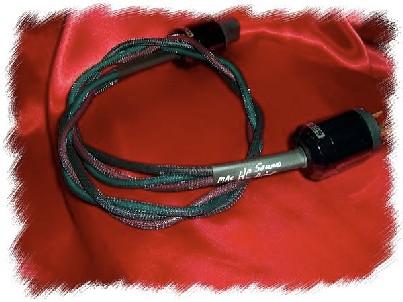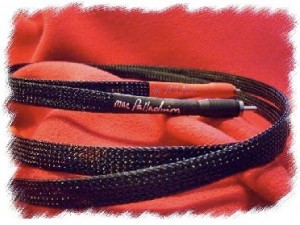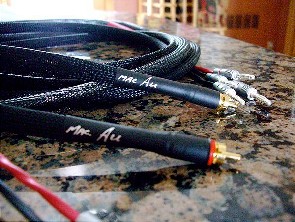A few weeks ago I recall saying to myself, “I don’t know what happened, but my system has never sounded better.” Over the past couple of months, I’ve changed out speaker cables and both power cords just for the hell of it. That’s it. Lateral moves price-wise. These changes offered big improvements. Now I can “hear” the recording studio, I can determine the quality of the microphone, I can tell if the microphones are positioned correctly on specific instruments, and I can even hear how much reverberation the sound engineer is adding to the vocals. But, of course, being an ardent tweaker, I want more.
I decided that since I was already content with the amp (Marsh A400), pre (Promitheus TVC), and CD player (modded Bada HD-22 tube CDP), the only thing left to experiment with were the interconnects. I began by purchasing a MAC HC Sound Pipe power cord to replace a PS Audio Prelude PC on my amp.
My Audio Cables (MAC) review
The MAC (www.myaudiocables.com) power cables are handmade using 10awg silver plated copper wire terminated with audio grade connectors. This power cord upgrade was immediately noticeable. After adding the HC Sound Pipe, the Prelude appeared to have been suffocating the bass. The Sound Pipe was like giving my system CPR. With this renewed energy, my system provided better bass and slightly more detail. Essentially, the Sound Pipe PC substantiated my experiences that power cords make a difference, but I didn’t expect the Sound Pipe to make such a big difference, especially at a cheaper price than the Prelude.
OK, so now I’m psyched and ready to try some more cables. I contacted Steve Hallick at MAC and he was kind enough to provide me with his top two cable offerings – the MAC Au and the Palladium. Both cables are handmade, unshielded, and dressed with standard black tech flex. They are distinguished by the name of the cable etched in silver on the black shrink wrap. Handle with care because these are delicate, lightweight cables. Steve offers other termination options, including Eichmann bullet plugs, at an additional cost. I evaluated both cables between my pre and CDP so I could compare them with one another and with the DH Labs Revelation pure silver cable that I’m currently using. I consider the Revelation to be a very balanced cable from top to bottom, with a slight hesitation on the bottom end. Generally, the Revelation is an excellent, musical interconnect in their own right, and offers great bang-for-buck. My music collection largely consists of contemporary jazz and blues, with an emphasis on female vocalists. I used the same familiar tracks for each demo from Lizz Wright’s “Dreaming Wide Awake,” Nicole Henry’s “The Nearness of You,” Rene Marie’s “Vertigo,” and Regina Belle’s “Love Songs.”
The MAC Au retails for an “affordable” $799 (other pure gold cables are priced at well over $2,000), but can be purchased brand new for less money on Audiogon. The cable consists of pure 22K gold conductors and gold plated connectors. Fortunately, since the MAC Au demos were already broken in, they were plug & play.
When one thinks of gold, they envision timeless beauty, brilliance, and radiance. This is, in fact, how these cables sound. My initial impression was that the MAC Au’s are like fine wine refined, soothing, and delicate. The MAC Au’s offered laser precision detail; they were very controlled and cautious, but not sterile. In other words, these cables are absolutely unforgiving, so if it’s on the CD, you’re gonna hear it. Period. So forget about listening to poorly recorded CDs. This is gold, dammit, so show some respect.
The stunning detail emanates from a pitch black background. While I was listening, I realized that compared to the DH Labs Revelation, the MAC Au cables are like going from a regular DVD picture to HD-DVD. These cables paint a vivid portrait; you can see everything – pimples and all. The cable’s clarity creates excellent decay and attack transients – the best I’ve heard.
The vocals are balanced, recessed, and airy. The bass is well defined, but not quite as deep as the Revelation, and they both share the same tonal quality. The MAC Au’s aren’t in a hurry to deliver the goods. The pace is somewhat slower than the Revelation (similar to the Kimber Hero I used to own). That’s why I suggest using these gold cables in systems that need a little assistance with refinement because they will likely mellow out a system that is slightly overbearing. Not surprisingly, the MAC Au’s would be best suited for classical, instrumental, and jazz music. Hard core rockers need not apply.
If you want to know what “warm” sounds like, get your ears on a pair of Palladiums. The MAC Palladium ICs, which retail for $429, are built using air as the primary dielectric and pure teflon as a secondary with minimal wall contact by the pure palladium conductors. The RCA connectors sport silver center conductors with a nickel plated brass body. I never heard of palladium, so a quick google search informed me that it is a soft, steel-white, tarnishresistant, metallic element occurs naturally with platinum, especially in gold, nickel, and copper ores. It is alloyed for use in electric contacts, jewelry, nonmagnetic watch parts, and surgical instruments.
My first reaction to the Palladium vs. the Au’s was quite interesting. I could literally hear the differences in these two cables from my upstairs office (the stereo system is downstairs and the music was playing softly). Each cable is remarkably distinct from one another. The Palladiums transported me into the recording’s epicenter and smothered me with its expansive soundstage. The Palladiums are “faster” than the Revelation and Au’s, and have no hint of brightness whatsoever. The Palladiums also have a more prominent sweet spot with big body bass. Sound flows like luscious syrup, and it’s intoxicatingly sweet.
Interestingly, one of the major attributes of the metal palladium is that it purifies by absorbing large amounts of hydrogen. And that’s how I would characterize the sound – purifying and absorbing. The most impressive aspect of the Palladiums was the emotionally engaging vocals. These cables provided the best vocal presentation I have ever heard. So if you enjoy female vocals, don’t hesitate to buy these cables.
The Palladiums are more melodious and spacious than any cable – interconnect or speaker – I have ever heard. While the Revelation and Au’s made the instruments sound distinct, the Palladiums served up musical gumbo. I suppose the term, “orchestral” is the best I can do to describe the sound. In other words, the faster speed of the Palladiums creates a smoother blending of the instruments. In a nutshell, the Palladiums filled in the gaps with everything I wanted my system to be. It simply sounds right. What more can I say?
At this level in the game, everyone is a winner. Each of the three interconnects are extraordinarily good at what they do. Not surprisingly, the choice comes down to personal preferences. Choose the Au’s for absolute clarity and detail, the Palladiums for emotionality and palpability, or the Revelation for overall musical presentation. For my taste, I’m saving my coins for a precious metal called “palladium.”
Bottom Line
Every now and then, you have to get adventurous and go “off the grid” in search of affordable audio components. Brand name audio cables can be costly, and in many cases, you’re paying a premium for the name, exotic appearance, and so-called “R&D.” MAC cables may not be a household name like Audioquest, Kimber, or MIT, but MAC provides tremendous sound quality at an astonishingly incredible value. If you’re looking to trade out your existing cables, I highly recommend MAC cables over many of the higher priced, brand name offerings. Happy listening!
 from affordableaudio, By Brad Mitchell
from affordableaudio, By Brad Mitchell


